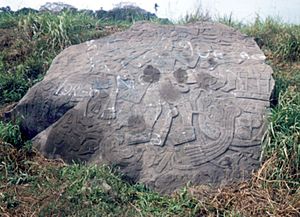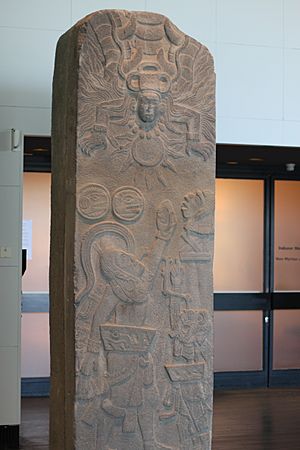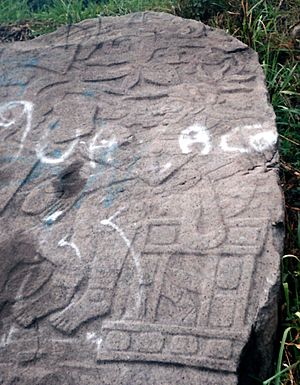Bilbao (Mesoamerican site) facts for kids
Bilbao is an ancient archaeological site in Guatemala. It's located about 1.6 kilometers (1 mile) from the modern town of Santa Lucía Cotzumalguapa. This important site is found among large sugar cane fields on Guatemala's Pacific coast. Bilbao was a major center for the Cotzumalhuapa culture, especially during the Late Classic period (around AD 600–800). The site gets its name from the old plantation it sits on.
Contents
Where is Bilbao?
Bilbao is on the edge of Santa Lucía Cotzumalguapa, about 370 meters (1,214 feet) above sea level. Bilbao, along with two other ancient sites called El Baúl and El Castillo, were all part of one big ancient city. This city covered about 10 square kilometers (4 square miles)! Archaeologists call this large area the Cotzumalhuapa Nuclear Zone. Bilbao is in the southern part of this zone. Today, the modern town of Santa Lucía Cotzumalguapa has grown right up to the edge of the ancient buildings.
A very important natural feature near the Cotzumalhuapa Nuclear Zone is the Volcán de Fuego. This is one of the most active volcanoes in the world! Its peak is about 3,835 meters (12,582 feet) high and is only about 21 kilometers (13 miles) from Bilbao. The volcano's activity must have affected the people living at Bilbao. They likely experienced regular falls of volcanic ash, which would have impacted their farming, travel, and homes.
History of Bilbao
Early Times (Preclassic Period)
People lived at Bilbao even in the very early times, known as the Preclassic period. During this time, Bilbao was the most important site in what later became the Cotzumalhuapa Nuclear Zone.
Later Times (Classic and Postclassic Periods)
Many pieces of pottery from the Middle and Late Classic periods (around AD 400-800) have been found at Bilbao. This shows that the site was very active during these times.
Even though most of the Cotzumalhuapa Nuclear Zone doesn't have many buildings from the Postclassic Period, Bilbao has one large residential area from this later time.
Modern Discovery
In 1860, a local official named Pedro de Anda cleared the land where the ancient ruins were to start a coffee farm. The farm was first called Finca Peor es Nada. Later, in 1890, it merged with another piece of land and became Finca Bilbao. In 1957, the plantation was renamed Finca Las Ilusiones.
People started studying the site in the late 1800s. In 1863, an Austrian doctor named Simeon Habel drew some of the sculptures. His drawings were published in 1878. Then, in 1876, Adolph Bastian from the Royal Museum in Berlin visited the site. He arranged for Carl H. Berendt to move the best monuments to Berlin in 1877. They shipped 31 sculptures from Puerto San José on the Pacific coast. Sadly, one monument was lost overboard! The rest arrived in Berlin in 1883. These included some amazing stone carvings of ancient ballplayers. In 1884, an engineer named Albert Napp mapped the site. His original map was lost for over a century but was found again in Berlin in 1994.
The Ancient City
The ancient buildings at Bilbao are mostly earth mounds, now covered by sugar cane fields. The style of the stone carvings at Bilbao is different from the famous Maya art. Some experts think it might show the influence of the Pipil people. These people spoke a language similar to Nahua (from central Mexico) and moved to the Pacific coast of Guatemala and El Salvador later on.
When Bilbao was first found, it was covered in thick forest. This forest was cleared for coffee farms, which were later replaced by sugar cane.
Archaeologists Lee A. Parsons and S. F. de Borhegyi have studied Bilbao. Parsons once thought Bilbao might have been a colony of the powerful city of Teotihuacán in central Mexico. However, another archaeologist, Marion Popenoe de Hatch, has since suggested that Bilbao was most important during the Late Classic period. The buildings at Bilbao are buried under a thick layer of volcanic soil, so only the largest structures can be seen as mounds.
The main part of Bilbao has several platforms that gently slope down to the south. These platforms seem to have been open areas without walls, easy for people to access. The large buildings at Bilbao might have been homes for important leaders and places for religious ceremonies.
The Monument Plaza was a key area. Most of the site's sculptures were found here, including Monuments 1 through 8, which are now in Berlin. People could enter the Plaza using ramps and stairways.
There are also several groups of structures:
- Group A is west of the Monument Plaza and has 6 buildings.
- Group B is north of Group A and has 4 buildings.
- Group C is north of Group B and has 3 buildings.
- Group D is north of Group C and has 4 buildings.
All these groups (A to D) are next to the Canilla River on their east side.
Ancient Roads (Causeways)
Bilbao was connected to other sites in the Cotzumalhuapa Nuclear Zone by a network of stone-paved roads called causeways. This shows that the whole area was like one big, connected city. There are three main causeways:
- The Gavarrete Causeway is 3 kilometers (1.9 miles) long and connects Bilbao with El Baúl. It was the main road of the city, about 11 to 14 meters (36 to 46 feet) wide. It's named after a Guatemalan historian.
- The Berendt Causeway is an extension of the Gavarrete Causeway. It's 1 kilometer (0.6 miles) long and links Bilbao with El Castillo.
- The Habel Causeway is 2 kilometers (1.2 miles) long and connects El Castillo with Golón, which is only 1 kilometer (0.6 miles) from Bilbao.
Amazing Sculptures
Archaeologists have listed 58 sculptures at Bilbao, but only 3 remain at the site today. Even before many were moved in the 1800s, some had already been damaged by locals who used them for building materials. The remaining large stone sculptures are found among the earth mounds of the site's main ceremonial area. These include two sculptures of the central Mexican god Tlaloc, carved into a large stone near a stream. Many of the buildings and stone carvings at Bilbao show images related to the ancient ballgame. These ballgame carvings often show plants with flowers and fruit, which were symbols of good harvests.
Some well-preserved "potbelly sculptures" have also been found at Bilbao. These are large stones carved to look like round, fat human figures. They are found at many ancient sites along the Pacific coast.
Here are some of the interesting sculptures:
- Monument 1 was carved during the Classic Period. It shows a ballplayer holding a knife in one hand and a head in the other. Four smaller figures are around him. This monument was moved to the Ethnological Museum of Berlin.
- Monument 3 shows a larger ballplayer and a smaller death god. Both are wearing special gear for the ballgame. They stand in front of a temple, and the ballplayer is offering a human heart to the sun. This monument is also in the Ethnological Museum of Berlin.
- Monument 4 shows a shaman (a spiritual leader) whose tongue looks like a knife. It was also moved to the Ethnological Museum of Berlin.
- Monument 17 was lost at sea! It was one of a pair of sculptures showing a vulture eating a human body. It fell overboard while being loaded onto a ship for Berlin. Only the tip of one wing survived.
- Monument 18 is a large, rectangular stone carving with a raised border. It shows three standing figures. One figure faces the other two. Between them is a rectangular object with crab claws. At the top, there's a circle with a monkey's head. This monument is from the Classic period.
- Monument 19 shows three figures. The main person wears a fancy headdress with a Xiuhcoatl (a "turquoise/fire serpent") plume. He seems to be helping someone who is less fortunate.
- Monument 21 is a large basalt stone in a sugar cane field. Its top surface was flattened and carved with a scene. The carving shows three main figures. The largest figure is in the middle and faces another figure sitting on a throne. A third, smaller figure is behind the central one, holding a hand puppet. The scene is filled with twisting vines that have cocoa pods with human faces. There are also birds, snakes, and a butterfly with a human head. This monument is from the Classic period. The design on one figure's skirt might be the face of the central Mexican god Xipe Totec.
- Monument 58 is a potbelly sculpture. When it was found, it was lying on its side with its head resting on the bottom step of a stairway. On top of it was Monument 59, which was upside down.
- Monument 59 is a stone altar or throne with four legs. It was found upside down on top of Monument 58. It might have originally held the potbelly sculpture.
Golón
Golón is another important area within the Cotzumalhuapa Nuclear Zone. It's about 1 kilometer (0.6 miles) from Bilbao and is connected by the same system of paved roads. Golón also has many ancient sculptures.
Images for kids
See also
 In Spanish: Bilbao (sitio arqueológico) para niños
In Spanish: Bilbao (sitio arqueológico) para niños









